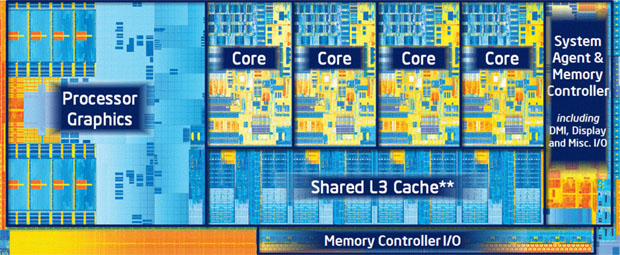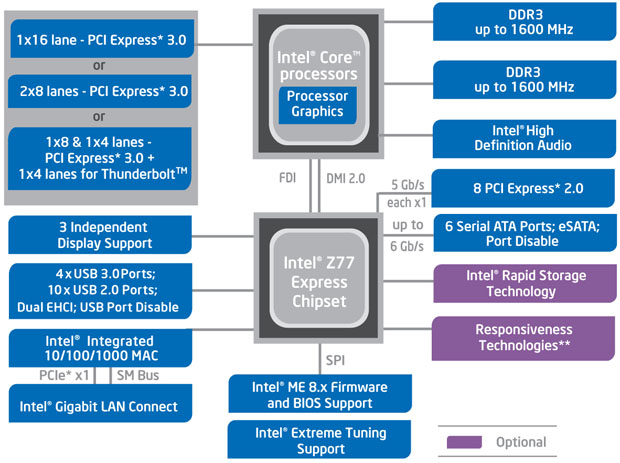Page 2 - Intel Core i7-3770K Architecture; Test System
With Intel's latest in the desktop microprocessor product line, this iteration of the code-named Ivy Bridge processors is the third generation of the company's popular Core i3/i5/i7 line of CPUs. Being the 'tick' part of Intel's 'tick-tock' release cycle, Ivy Bridge brings one major change to the table: a die shrink from 32nm to 22nm. Wait a second. Did I just say 'tick'? Well, Intel would like to say otherwise, so let's make it a 'tick+'. What this boils down to no other than a significantly improved integrated graphics solution. I am not sure how much this actually means to you, because I am not completely aware of anyone who goes out and buys a buys a processor aimed at enthusiasts that costs over $300 and ends up not having a dedicated graphics card, haha. Either way, we will dig down to the details in just a moment; but for now, all you need to know is Ivy will play nice with your last generation P67 and Z68 LGA 1155 motherboards, as long as a proper BIOS update is provided by the manufacturer. Cool.
The current family of Intel Ivy Bridge Core i-series desktop processors includes:
Core i7: 3770K, 3770, 3770S, 3770T
Core i5: 3570K, 3570, 3570S, 3570T, 3550, 3550S, 3475S, 3470, 3470S, 3470T, 3450, 3450S, 3330, 33330S
Core i3: 3240, 3225, 3220
The 'K' suffix denotes unlocked multiplier, 'S' for a low power processor, and 'T' for an ultra low power processor. The Intel Core i7-3770K has a rated TDP of 77W. We will take a look into its true power consumption later on in this review.

Other than the 22nm die shrink, Intel's "tick+" marketing label wants you to understand that this is not just a simple change from 32nm to 22nm with everything else carried over from the last generation. The new Intel HD Graphics 4000 promises a significant boost in integrated graphics performance; now armed with a base frequency of 650MHz and sixteen execution units -- up four from last year. It can dynamically overclock itself up to 1.15GHz automatically, and scales down to 350MHz when not under load. Since this is an enthusiast processor review, I am not going to bother benchmarking the Core i7-3770K in this regard, but for office users who would like to run a light game at lunch on office computers, you are in luck, haha. Do keep in mind that while it is faster than previous generation integrated graphics, don't expect to dump your expensive AMD or NVIDIA cards in your high end gaming rig at home, and expect a top notch experience in return anytime soon. That said, Intel's HD Graphics 4000 now provides support for three monitors, along with DirectX 11, OpenCL, DirectCompute, and improved Quick Sync performance.
Along with the added features, this monolithic piece of silicon now packs 1.4 billion transistors under the hood -- up from 995 million from last generation Sandy Bridge core processors. Combined with Intel's new 3D Transistor technology, everything is packed into a die size of only 160mm². With other small enhancements here and there, such as embedded power gated DDR3 I/O, the company promises reduced power consumption, which we will examine later in this review as aforementioned. This brings us to the diagram above, which gives a nice microscopic view into the physical layout of this Ivy Bridge CPUs. 32KB of 8-way cache for both data and instruction makes up the 64KB L1 cache; followed by 256KB of 8-way L2 cache per core for a total of 1024KB combined. The 16-way L3 "Smart Cache" is pooled in the middle so it can be used by both the processor cores and the integrated graphics core as aforementioned simultaneously. Ivy Bridge Core i7 processors such as the 3770K we are reviewing today have 8MB cache; while Core i3s and Core i5s carry 3MB and 3MB or 8MB, respectively.
Third generation Intel Core i7s like the 3770K we are reviewing today has four physical cores. The 'K' indicates an unlocked multiplier, and will run you about $20 more than a vanilla, locked i7-3770 at press time. Meanwhile, third generation Core i3s will have two physical cores with Hyper-Threading. Like previous generation Sandy Bridge processors, the main difference between Core i5 and i7s, other than quantity of cache, is that the latter supports Hyper-Threading for up to eight simultaneous threads (Four physical cores and four logical cores). Media related multithreaded applications optimized for Hyper-Threading will benefit the most from this technology, but in many other cases, the lack of such will not affect performance to a significant degree.
Additionally, Intel has a duo of security features for software developers to take advantage of. The Supervisory Mode Execute Protection (SMEP) separates allocated system memory into four different protection "rings". Basically, it prevents applications that are allocated on a lower tier to execute instructions out of the trusted memory ring. This is used to help prevent escalation of privilege attacks. The Digital Random Number Generator (DRNG) provides a reasonably fast and reliable source of random numbers, up to 2 to 3Gb/s, and are available to system software -- operating system and installed programs -- at all levels.

Six new chipsets designed for Ivy Bridge processors are available at press time, including the Z77, Z75, H77, Q77, Q75, and B75. Previous generation chipsets such as P67 and Z68 can support Ivy Bridge, given a proper BIOS update is available from your motherboard manufacturer. All 7-series chipsets are backwards compatible with Sandy Bridge CPUs. Codenamed Panther Point, for most people who are looking to buy a Core i7-3770K, Z77 is probably the only relevant chipset to you, since this is the enthusiast oriented product. Branching off the processor are sixteen available PCI Express 3.0 lanes, and can be set to either 1x16, 2x8, or 1x8/1x4 plus a Thunderbolt port, as shown in the block diagram above. The Platform Controller Hub provides eight PCI Express 2.0 lanes. Ivy Bridge CPUs also has native support for a pair of dual channel DDR3-1600 RAM slots, and can scale up to DDR3-2800 speeds. We are also happy to finally see native support for up to four USB 3.0 ports (Previous chipsets had USB 3.0 support only via a third party controller) and two SATA 6Gb/s ports for your ballin' SSDs. Four additional SATA 3Gb/s ports are provided for everything else. The rated TDP for all Panther Point chipsets is 6.7W.
Our test configuration as follows:
Compared Hardware:
- Intel Core i7-3770K (4 Cores/8 Threads, 3.5GHz Normal, 3.9GHz Turbo)
- Intel Core i5-2405S (4 Cores/4 Threads, 2.5GHz Normal, 3.3GHz Turbo)
- Intel Core i5-2500K (4 Cores/4 Threads, 3.3GHz Normal, 3.7GHz Turbo)
Common Specifications:
CPU Cooling: Arctic Cooling Freezer 13 Pro
Motherboard: Intel Desktop Board DZ77GA-70K
RAM: G.Skill Ares F3-1600C8Q-16GAB 4x4GB
Graphics: Gigabyte Radeon HD 7870 2GB OC
Chassis: NZXT Switch 810
Storage OCZ Agility 3 240GB
Power: Thermaltake Toughpower XT Platinum 1275W
Sound: Integrated
Optical Drive: None
Operating System: Microsoft Windows 7 Professional SP1 x64
Page Index
1. Introduction and Specifications
2. Intel Core i7-3770K Architecture; Test System
3. Benchmark: AIDA64 CPU
4. Benchmark: AIDA64 FPU
5. Benchmark: AIDA64 Memory
6. Benchmark: BAPCo SYSmark 2012
7. Benchmark: PCMark 7
8. Benchmark: 3DMark 11
9. Benchmark: PassMark PerformanceTest 7.0
10. Benchmark: SuperPI 1M, Cinebench R11.5
11. Overclocking, Power Consumption, and Conclusion





